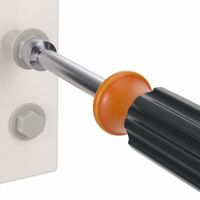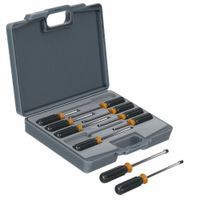Call +(254) 703 030 000 / 751 483 999 / 721 704 777
- Home
- Tools
- Hand Tools
- Screwdrivers Nut Drivers Keys
- Nut Drivers Sets
.....Read More
Frequently Asked Questions
What is a nut driver used for?
A nut driver is a hand tool used for tightening or loosening nuts and bolts. It resembles a screwdriver but has a socket head instead of a flat or Phillips head, allowing it to fit over hexagonal nuts and bolts. Nut drivers are commonly used in various applications, including automotive repair, electronics assembly, appliance maintenance, and general household tasks. They provide a more efficient and secure grip on nuts compared to pliers or wrenches, especially in tight or confined spaces. Nut drivers come in different sizes to match the specific dimensions of the nuts being worked on, ensuring a snug fit and reducing the risk of stripping or damaging the fastener. They are available in both metric and imperial measurements to accommodate different standards. Nut drivers can have a solid or hollow shaft, with the latter allowing for the accommodation of longer bolts. The handle is typically ergonomically designed for comfort and to provide adequate torque. Some nut drivers are part of interchangeable bit sets, offering versatility for various tasks. Electricians, HVAC technicians, and mechanics frequently use nut drivers due to their precision and ease of use.
How do you use a nut driver?
A nut driver is a hand tool used to tighten or loosen nuts and bolts. To use a nut driver, follow these steps:
1. **Select the Right Size**: Choose a nut driver that matches the size of the nut or bolt head you are working with. Using the correct size ensures a secure grip and prevents damage.
2. **Inspect the Tool**: Check the nut driver for any damage or wear. Ensure the handle is secure and the shaft is straight.
3. **Position the Nut Driver**: Align the socket of the nut driver with the nut or bolt head. Ensure it fits snugly over the nut to avoid slipping.
4. **Grip the Handle**: Hold the handle of the nut driver firmly with your dominant hand. Use your other hand to stabilize the workpiece if necessary.
5. **Apply Torque**: Turn the nut driver clockwise to tighten the nut or counterclockwise to loosen it. Apply steady pressure to avoid stripping the nut.
6. **Check Tightness**: Once tightened, check the nut to ensure it is secure. Avoid over-tightening, which can damage the threads or the workpiece.
7. **Remove the Nut Driver**: Once the task is complete, carefully remove the nut driver from the nut or bolt head.
8. **Store Properly**: Clean the nut driver if necessary and store it in a dry place to prevent rust and damage.
By following these steps, you can effectively use a nut driver for various fastening tasks.
What sizes do nut drivers come in?
Nut drivers come in a variety of sizes to accommodate different nut and bolt dimensions. The sizes are typically measured in either metric or imperial (SAE) units.
In the metric system, common nut driver sizes include:
- 4 mm
- 5 mm
- 5.5 mm
- 6 mm
- 7 mm
- 8 mm
- 9 mm
- 10 mm
- 11 mm
- 12 mm
- 13 mm
- 14 mm
In the imperial system, common sizes are:
- 3/16 inch
- 1/4 inch
- 5/16 inch
- 11/32 inch
- 3/8 inch
- 7/16 inch
- 1/2 inch
- 9/16 inch
- 5/8 inch
- 11/16 inch
- 3/4 inch
Nut drivers are often sold in sets that include a range of sizes to cover various applications. The choice of size depends on the specific nut or bolt being worked on, and having a comprehensive set ensures compatibility with a wide range of fasteners.
What is the difference between a nut driver and a socket wrench?
A nut driver and a socket wrench are both tools used for tightening and loosening nuts and bolts, but they differ in design, functionality, and application.
A nut driver resembles a screwdriver but has a socket permanently attached to its shaft. It is designed for turning nuts and bolts of a specific size. Nut drivers are typically used for lighter applications and are favored for their simplicity and ease of use. They are ideal for tasks requiring speed and efficiency, such as assembling electronics or working with small machinery. Nut drivers are available in both metric and imperial sizes, and they often come in sets to accommodate different nut sizes.
A socket wrench, on the other hand, is a more versatile tool. It consists of a handle with a ratcheting mechanism and interchangeable sockets that fit over nuts and bolts. The ratcheting feature allows for continuous turning without repositioning the tool, making it suitable for working in tight spaces. Socket wrenches are used for a wide range of applications, from automotive repair to heavy machinery maintenance. They come in various drive sizes (e.g., 1/4-inch, 3/8-inch, 1/2-inch) and can accommodate a wide range of socket sizes, making them adaptable to different tasks.
In summary, the main differences lie in their design and use: nut drivers are simpler, fixed-size tools for lighter tasks, while socket wrenches are more complex, versatile tools suitable for heavier-duty applications.
Can nut drivers be used for high torque applications?
Nut drivers are generally not suitable for high torque applications. They are hand tools designed for driving nuts and bolts with a hexagonal head, typically used in light to medium-duty tasks. Nut drivers are ideal for applications requiring precision and control, such as electronics assembly, appliance repair, and light mechanical work.
The design of a nut driver, which includes a handle and a shaft with a socket at the end, limits the amount of torque that can be applied. The handle is usually made of plastic or rubber, which can deform or break under excessive force. Additionally, the shaft is often made of materials that are not intended to withstand high torque, such as chrome vanadium or carbon steel, which can bend or snap if overloaded.
For high torque applications, tools like impact wrenches, torque wrenches, or breaker bars are more appropriate. These tools are specifically designed to handle the stress and force required to tighten or loosen fasteners in heavy-duty settings, such as automotive repair, construction, and industrial maintenance. They are constructed with robust materials and ergonomic designs to provide the necessary leverage and durability.
In summary, while nut drivers are useful for many tasks, they are not designed for high torque applications. Using them in such scenarios can lead to tool failure and potential injury. For tasks requiring high torque, it is advisable to use tools specifically engineered for that purpose.
What materials are nut drivers made from?
Nut drivers are typically made from a combination of materials to ensure durability, functionality, and comfort. The main components of a nut driver are the handle, the shaft, and the socket.
1. **Handle**: The handle is often made from materials like plastic, rubber, or a combination of both. High-quality nut drivers may use thermoplastic elastomers (TPE) or polypropylene for a comfortable grip. Some handles are ergonomically designed and may include rubber overmolds to provide a non-slip grip, reducing hand fatigue during prolonged use.
2. **Shaft**: The shaft, which connects the handle to the socket, is usually made from steel. Common types of steel used include chrome vanadium steel or carbon steel, which are chosen for their strength and resistance to twisting or bending. The steel shaft is often chrome-plated or nickel-plated to prevent rust and corrosion, extending the tool's lifespan.
3. **Socket**: The socket, which fits over the nut or bolt, is also typically made from steel, such as chrome vanadium or alloy steel, for its durability and ability to withstand high torque. The socket may be heat-treated to enhance its hardness and wear resistance. Some sockets are coated with a protective finish, like black oxide, to further prevent corrosion.
Overall, the combination of these materials ensures that nut drivers are robust, reliable, and comfortable to use, making them essential tools for various mechanical and electrical applications.
How do you maintain and store nut drivers?
To maintain and store nut drivers effectively, follow these steps:
1. **Cleaning**: After each use, wipe the nut drivers with a clean cloth to remove dirt, grease, and debris. For stubborn grime, use a mild detergent and water, ensuring the tool is thoroughly dried afterward to prevent rust.
2. **Inspection**: Regularly inspect the nut drivers for wear and damage. Check the handle for cracks and the shaft for bends or rust. Ensure the socket is not worn out, which can lead to slippage.
3. **Lubrication**: Occasionally apply a light machine oil to the metal parts to prevent rust and ensure smooth operation. Avoid over-lubricating, as excess oil can attract dirt.
4. **Sharpening**: If the nut driver has a cutting edge or is part of a multi-tool, ensure it is kept sharp using appropriate sharpening tools.
5. **Storage**: Store nut drivers in a dry, cool place to prevent rust. Use a tool chest, toolbox, or wall-mounted rack to keep them organized and easily accessible. Consider using a tool roll or pouch for portability and protection.
6. **Organization**: Arrange nut drivers by size or type to quickly find the right tool. Label storage compartments if necessary.
7. **Protection**: Use protective caps or covers for the tips to prevent damage and injury. Ensure the storage area is free from moisture and extreme temperatures.
8. **Inventory**: Keep an inventory of your nut drivers to track usage and identify when replacements are needed.
By following these steps, you can extend the life of your nut drivers and ensure they are always ready for use.

